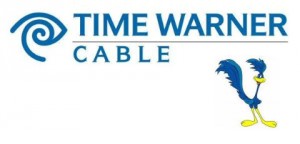Time Warner Cable is nearing the end of a licensing deal that has allowed the company to use a familiar Warner Bros. animated character to promote their broadband service.
The company has spent at least a year transitioning customers away from the Road Runner brand name, now simply referring to their broadband product as “Internet” or, in some markets, “HSI” — High Speed Internet.
The “brand refresh” comes as Time Warner tries to associate all of its products and services around its traditional “eye-ear” logo, according to company spokeswoman Jeannette Castaneda.
Licensing the Road Runner character as the broadband service’s mascot has also been expensive, and the continued need to use the character to educate consumers about the speed benefits of cable broadband over DSL has diminished in importance.
The transition away from the Road Runner brand has been ongoing since last summer, but Broadband Reports notes numerous markets will see the brand and logo eliminated completely effective May 19th. The company is also using the occasion to adjust pricing and tiers of its broadband service. Hardest hit will be standalone broadband-only customers, who will now pay $53.95 a month for Time Warner’s standard 10/1Mbps Internet service. New customers will also pay a modem rental fee of $2.50 a month. Standalone Turbo (20/2Mbps) customers will pay $73.95 for their Internet service.
Time Warner Cable’s a-la-carte pricing for broadband is designed to make their bundled service offerings more attractive in comparison. The company will sell you Internet-only service for $73.95, or sell you a triple play package of phone, Internet, and television service for just $16.04 per month more on a 12-month promotion.
Broadband Reports‘ source lists pricing for one unspecified market:
- $53.95 for Time Warner’s 10/1Mbps Standard Internet
- $20.00 additional for 20/2 Turbo
- $30.00 additional for 30/5 Extreme
- $50.00 additional for 50/5 Ultimate
- $29.95 for 1/1 Lite (Usually a retention only offer)
- $42.95 for 3/1 Basic
Customers can avoid paying regular pricing by bundling multiple services together, getting a customer retention deal when threatening to cancel service, or bouncing between a six-month new customer promotion available from Earthlink over Time Warner Cable and the cable company’s own broadband promotional offer, good for 12 months. Both cost $29.99 a month in many markets.

Time Warner Cable's marketing machine pushes customers towards multi-service bundles. New customers pay even less.
[flv width=”480″ height=”380″]http://www.phillipdampier.com/video/Road Runner 2002 Ad.mp4[/flv]
A Time Warner Cable Road Runner advertisement from 2002. (1 minute)


 Subscribe
Subscribe


I just called twc to ask if there is going to be a price increase in my area The csr. said she is not aware of one . I live in kc area close to where google fiber is supposed to launch in june I myself can not get in my google in area but because google is still pretty close I hope it will keep the heat on twc.
KCMO and KCK will almost certainly remain very aggressively priced because of Google competition, and the granularity of that pricing should be city-wide, regardless of whether your specific neighborhood is getting Google fiber.
All of this pricing information is regionally-sensitive and may vary. If TWC rates are too high for you, call and threaten to cancel and they’ll lower them.
So what will happen with the “.rr” e-mail address?
My personal guess is they will not be touched for the foreseeable future. E-mail addresses are an incredibly customer sensitive issue and many people even print them on business cards. I suspect they will leave rr.com alone for existing customers and perhaps issue new e-mail addresses for new customers under a different domain (and offer existing customers one if they want one).
One of the things that keeps people tied to their ISP is the unwillingness to give up their e-mail address. Forcing them to will be an invitation for customers to depart.
This isn’t really news. Yes, branding is changing, but those speeds have been available in a number of TWC areas for months. Prickng might be up a few dollars with the change, but there’s no proof of that yet either.
Let me know when the company does something bigger, like capping subscribers or introducing faster upstream speeds.